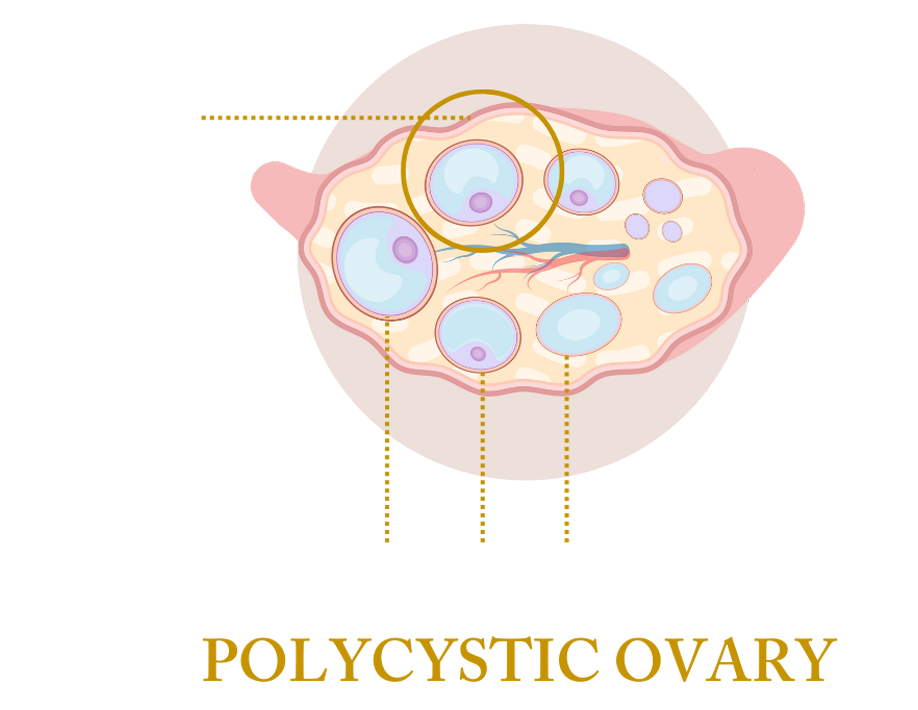Polycystic Ovarian Syndrome (PCOS)
What is Polycystic Ovarian Syndrome (PCOS)?
Polycystic ovary syndrome (PCOS) is a problem with hormones that happens during the reproductive years. It can cause irregular/missed periods and also too much of a hormone called androgen in your body. Small sacs of fluid develop along the outer edge of the ovary, these are called cysts, the small fluid-filled cysts contain immature eggs. These are called follicles. The follicles fail to regularly release eggs.
Symptoms of Polycystic Ovarian Syndrome (PCOS)
A diagnosis of PCOS is made when you have at least two of these:
Irregular periods
Having few /irregular menstrual periods. E.g fewer than nine periods a year and may occur more than 35 days apart. You may have trouble getting pregnant.
Too much androgen
High levels of the hormone androgen may result in excess facial and body hair. This is called hirsutism. Sometimes, severe acne and male-pattern baldness can happen, too.
Polycystic ovaries
Your ovaries might be bigger. Many follicles containing immature eggs may develop around the edge of the ovary. The ovaries might not work the way they should.
The causes of Polycystic Ovarian Syndrome (PCOS)
The exact cause of PCOS isn't known. Factors that might play a role include:
Insulin resistance
Low-grade inflammation
Heredity
Excess androgen
The complications of Polycystic Ovarian Syndrome (PCOS)COS
The exact cause of PCOS isn't known. Factors that might play a role include:
Infertility
Gestational diabetes or pregnancy-induced high blood pressure
Miscarriage or premature birth
Nonalcoholic steatohepatitis
Metabolic syndrome — a cluster of conditions including high blood pressure, high blood sugar, and unhealthy cholesterol or triglyceride levels that significantly increase your risk of heart and blood vessel (cardiovascular) disease
Type 2 diabetes or prediabetes
Sleep apnea
Depression, anxiety and eating disorders
Cancer of the uterine lining (endometrial cancer)
How do you diagnose Polycystic Ovarian Syndrome (PCOS)?
There's no single test to specifically diagnose polycystic ovary syndrome (PCOS). Your health care provider is likely to start with a discussion of your symptoms, medications and any other medical conditions. Your provider also may ask about your menstrual periods and any weight changes. A physical exam includes checking for signs of excess hair growth, insulin resistance and acne.
Your health care provider might then recommend:
Pelvic exam. During a pelvic exam, your provider can check your reproductive organs for masses, growths or other changes.
Blood tests. Blood tests can measure hormone levels. This testing can exclude possible causes of menstrual problems or androgen excess that mimic PCOS. You might have other blood testing, such as fasting cholesterol and triglyceride levels. A glucose tolerance test can measure your body's response to sugar (glucose).
Ultrasound. An ultrasound can check the appearance of your ovaries and the thickness of the lining of your uterus. A wandlike device (transducer) is placed in your vagina. The transducer emits sound waves that are translated into images on a computer screen.
If you have a diagnosis of PCOS, your provider might recommend more tests for complications. These tests can include:
Regular checks of blood pressure, glucose tolerance, and cholesterol and triglyceride levels
Screening for depression and anxiety
Screening for obstructive sleep apnea
Seeing a WYLD chiropractor will allow women with PCOS and fertility issues to have their spine properly aligned.
By doing so, anything that was interfering with the nervous systems operations may be cleared away.
Our Chiropractors can also advise on exercise, healthy lifestyle choices, and nutrition.
Our Approach For Chiropractic Care
Gentle and effective treatment
Comfort with state of the art Chiropractic equipment
Safe for people of all ages
What To Expect At Your First Chiropractic Visit
An initial Chiropractic exam will typically have three parts: a consultation, case history, and physical examination.
Laboratory analysis and X-ray examination may be performed.
Consultation. The patient meets with the chiropractor and provides a brief synopsis of lifestyle factors and concerns, such as:
Duration and frequency of symptoms
Description of the symptoms (e.g. burning, throbbing)
Areas of pain
What makes the pain feel better (e.g. sitting, stretching)
What makes the pain feel worse (e.g. standing, lifting)
Lifestyle factors
Case history. The chiropractor identifies the area(s) of complaint and the nature of the stress involved by asking questions and learning more about different areas of the patient's history, including:
Family history
Dietary habits
Past history of other treatments (chiropractic, osteopathic, medical and other)
Occupational history
Psychosocial history
Other areas to probe, often based on responses to above questions
Physical examination. A chiropractor may utilize a variety of methods to determine the spinal segments that require chiropractic treatments, including but not limited to static and motion palpation techniques determining spinal segments that are hypo mobile (restricted in their movement) or fixated. Depending on the results of the above examination, a chiropractor may use additional diagnostic tests, such as:
X-ray to locate subluxations (the altered position of the vertebra)
A device that detects the temperature of the skin in the paraspinal region to identify spinal areas with a significant temperature variance that requires manipulation.
Chiropractors are trained in a variety of methods to assess the underlying cause of the problem, including:
Evaluation and management services. Chiropractors are trained in examining the joints, bones, muscles and tendons of the spine, head, extremities and other areas of the body with the purpose of noting any misalignment, tenderness, asymmetry, defects or other problems.
Neurologic and other common physical examination procedures. Chiropractors are trained to perform a variety of neurologic tests (nerve root compression/tension, motor strength, coordination, deep tendon and pathological reflexes, etc.) and are skilled in performing orthopedic, cardiovascular and many other common examinations.
Specialised assessment. Chiropractors are trained to assess range of motion, stability, muscle strength, muscle tone and other assessments with the lower back.
Common diagnostic studies. Chiropractors are trained in use of diagnostic studies and tools such as radiography (X-rays), laboratory diagnostics and neurodiagnostics.
References:
https://crh.ucsf.edu/research/fertility-research/pcos-research
https://www.frontiersin.org/articles/10.3389/fendo.2022.808898/full
https://www.news-medical.net/health/Recent-Research-into-Polycystic-Ovary-Syndrome.aspx
https://journals.plos.org/plosone/article?id=10.1371/journal.pone.0247486
https://livingvitallife.com/chiropractic-care-can-help-with-pcos/
https://charlottechiropractor.com/find-relief-from-pcos-with-neurologically-based-chiropractic-care/
https://chiro.org/nutrition/ABSTRACTS/Polycystic_Ovary_Syndrome.shtml






